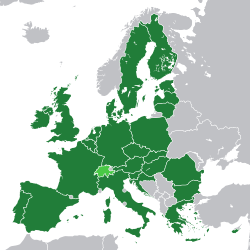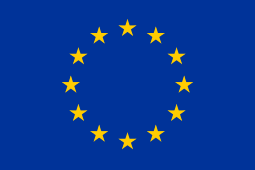European Atomic Energy Community
European Atomic Energy Community
(EAEC / Euratom)
| |
|---|---|

| |
| Administrative body | European Commission |
| Official languages | 24 languages |
| Type | International organisation |
| Members |
28 EU member states 1 associated state |
| Establishment | 1958 |
| 1 January 1958 | |
| 1 July 1967 | |
The European Atomic Energy Community (EAEC or Euratom) is an international organisation founded in 1957 with the purpose of creating a specialist market for nuclear power in Europe, developing nuclear energy and distributing it to its member states while selling the surplus to non-member states. It is legally distinct from the European Union (EU), but has the same membership, and is governed by many of the EU's institutions. Since 2014, Switzerland has also participated in Euratom programmes as an associated state.[1]
Currently, its main focus is on the construction of the International Fusion Reactor ITER[2] financed under the nuclear part of FP7. Euratom also provides a mechanism for providing loans to finance nuclear projects in the EU.
It was established by the Euratom Treaty on 25 March 1957 alongside the European Economic Community (EEC), being taken over by the executive institutions of the EEC in 1967. Although all other European postwar communities were merged into the EEC and then the EU, Euroatom has maintained its legally distinct nature and is the only remaining community organization that is independent from the European Union and therefore outside the regulatory control of the European Parliament.
History

The Common Assembly proposed extending the powers of the European Coal and Steel Community to cover other sources of energy. However, Jean Monnet, ECSC architect and President, wanted a separate community to cover nuclear power. Louis Armand was put in charge of a study into the prospects of nuclear energy use in Europe; his report concluded that further nuclear development was needed to fill the deficit left by the exhaustion of coal deposits and to reduce dependence on oil producers. However, the Benelux states and Germany were also keen on creating a general single market, although it was opposed by France due to its protectionism, and Jean Monnet thought it too large and difficult a task. In the end, Monnet proposed the creation of separate atomic energy and economic communities to reconcile both groups.[3]
The Intergovernmental Conference on the Common Market and Euratom at Val Duchesse in 1956 drew up the essentials of the new treaties. Euratom would foster co-operation in the nuclear field, at the time a very popular area, and would, along with the EEC, share the Common Assembly and Court of Justice of the ECSC, but not its executives. Euratom would have its own Council and Commission, with fewer powers than the High Authority of the European Coal and Steel Community. On 25 March 1957, the Treaties of Rome (the Euratom Treaty and the EEC Treaty) were signed by the ECSC members and on 1 January 1958 they came into force.[4][5][6]
To save on resources, these separate executives created by the Rome Treaties were merged in 1965 by the Merger Treaty. The institutions of the EEC would take over responsibilities for the running of the EEC and Euratom, with all three then becoming known as the European Communities even if each legally existed separately. In 1993, the Maastricht Treaty created the European Union, which absorbed the Communities into the European Community pillar, yet Euratom still maintained a distinct legal personality.
The European Constitution was intended to consolidate all previous treaties and increase democratic accountability in them. The Euratom treaty had not been amended as the other treaties had, so the European Parliament had been granted few powers over it. However, the reason it had gone unamended was the same reason the Constitution left it to remain separate from the rest of the EU: anti-nuclear sentiment among the European electorate, which may unnecessarily turn voters against the treaty.[7][8][9] The Euratom treaty thus remains in force relatively unamended from its original signing.
EU evolution timeline
| Signed: In force: Document: |
1948 1948 Brussels Treaty |
1951 1952 Paris Treaty |
1954 1955 Modified Brussels Treaty |
1957 1958 Rome Treaty & EURATOM |
1965 1967 Merger Treaty |
1975 1976 Council Agreement on TREVI |
1986 1987 Single European Act |
1985+90 1995 Schengen Treaty & Convention |
1992 1993 Maastricht Treaty (TEU) |
1997 1999 Amsterdam Treaty |
2001 2003 Nice Treaty |
2007 2009 Lisbon Treaty |
|||
| Content: | (founded WUDO) | (founded ECSC) | (protocol amending WUDO to become WEU) | (founded EEC and EURATOM) | (merging the legislative & administrative bodies of the 3 European communities) | (founded TREVI) | (amended: EURATOM, ECSC, EEC)+ (founded EPC) |
(founded Schengen) (implemented Schengen) |
(amended: EURATOM, ECSC, and EEC to transform it into EC)+ (founded: JHA+CFSP) |
(amended: EURATOM, ECSC, EC to also contain Schengen, and TEU where PJCC replaced JHA) | (amended with focus on institutional changes: EURATOM, ECSC, EC and TEU) | (abolished the 3 pillars and WEU by amending: EURATOM, EC=>TFEU, and TEU) (founded EU as an overall legal unit with Charter of Fundamental Rights, and reformed governance structures & decision procedures) |
|||
| Three pillars of the European Union: | |||||||||||||||
| European Communities (with a single Commission & Council) |
|||||||||||||||
| European Atomic Energy Community (EURATOM) | |||||||||||||||
| European Coal and Steel Community (ECSC) | Treaty expired in 2002 | European Union (EU) | |||||||||||||
| European Economic Community (EEC) | European Community (EC) | ||||||||||||||
| Schengen Rules | |||||||||||||||
| Terrorism, Radicalism, Extremism and Violence Internationally (TREVI) | Justice and Home Affairs (JHA) |
Police and Judicial Co-operation in Criminal Matters (PJCC) | |||||||||||||
| European Political Cooperation (EPC) | Common Foreign and Security Policy (CFSP) | ||||||||||||||
| Western Union Defence Organization (WUDO) | Western European Union (WEU) | ||||||||||||||
| Treaty terminated in 2011 | |||||||||||||||
Expansion
| European Union |
 This article is part of a series on the |
Policies and issues
|
Since 2014, Switzerland has participated in Euratom programmes as an associated state.[1]
As of 2016, the community had co-operation agreements of various scopes with eight countries: the United States, Japan, Canada, Australia, Kazakhstan, Ukraine, Uzbekistan and South Africa.[10]
Withdrawal of the United Kingdom
The United Kingdom announced its intention to withdraw from the EAEC on 26 January 2017, following on from its decision to withdraw from the European Union.[10][11][12][13] Formal notice to withdraw from the EAEC was provided in March 2017, within the Article 50 notification letter, where the withdrawal was made explicit.[14] Withdrawal will only become effective following negotiations on the terms of the exit, which are scheduled to last two years.
A report by the House of Commons Business, Energy and Industrial Strategy Committee, published in May 2017, questioned the legal necessity of leaving Euratom and called for a temporary extension of membership to allow time for new arrangements to be made.[15]
In June 2017, the European Commission's negotiations task force published a Position paper transmitted to EU27 on nuclear materials and safeguard equipment (Euratom), titled "Essential Principles on nuclear materials and safeguard equipment".[16] The following month, a briefing paper from the House of Commons Library assessed the implications of leaving Euratom.[17]
If the UK withdraws, it might raise the question of UK nuclear fuel availability after 2019 and the need for new treaties relating to the transportation of nuclear materials.[18]
UK politicians have raised the possibility of staying in the Euratom, but currently this is mostly theoretical speculation. Some argue that staying in the Euratom will require – beyond the consent of the EU27 – amendment or revocation of the Article 50 letter of March 2017.[19]
Achievements
In the history of European regulation, Article 37 of the Euratom Treaty represents pioneering legislation concerning binding transfrontier obligations with respect to environmental impact and protection of humans.[20]
Presidents of the EAEC
The five member Commission was led by only three presidents while it had independent executives (1958–1967), all from France:
- Louis Armand (France) 1958–1959 – Armand Commission
- Étienne Hirsch (France) 1959–1962 – Hirsch Commission
- Pierre Chatenet (France) 1962–1967 – Chatenet Commission
See also
- EU Directorate General Joint Research Centre – often incorrectly referred to as Euratom due to EURATOM being its origin.
- Energy Community
- Energy policy of the European Union
- History of the European Union
- Institutions of the European Union
- International Atomic Energy Agency
- Nuclear energy in the European Union
- The nuclear part of the Seventh Framework Programme for research and technological development, the European Union's chief instrument for funding research.
References
- 1 2 Document 32014D0954, Council of the European Union. Retrieved 26 October 2015.
- ↑ Fusion for Energy
- ↑ 1957–1968 Successes and crises CVCE
- ↑ A European Atomic Energy Community CVCE
- ↑ The signing of the Rome Treaties CVCE
- ↑ Drafting of the Rome Treaties CVCE
- ↑ Euratom: nuking Europe's future Greenpeace International, 9 July 2003
- ↑ One hundred civil society groups say abolish Euratom! Friends of the Earth Europe, 3 March 2003
- ↑ Euratom reform
- 1 2 Alex Barker, Arthur Beesley (26 January 2017). "UK confirms plan to leave European atomic energy community". Financial Times. Retrieved 27 January 2017.
- ↑ Britain quits European nuclear body
- ↑ Adam Vaughan (27 January 2017). "UK exit from EU atomic treaty under Brexit 'will delay power stations'". The Guardian. Retrieved 27 January 2017.
- ↑ http://www.nature.com/news/researchers-shocked-at-uk-s-plan-to-exit-eu-nuclear-agency-1.21388
- ↑ "Prime Minister May's letter to EU" (PDF). Government of the United Kingdom. 2017-03-29. Retrieved 2017-04-01.
- ↑ "Government must act urgently to end Brexit risk to nuclear industry". UK Parliament. Retrieved 8 July 2017.
- ↑ "Position paper transmitted to EU27 on nuclear materials and safeguard equipment (Euratom)". European Commission. 23 June 2017. Retrieved 27 June 2017.
- ↑ Hinson, Suzanna (7 July 2017). "Briefing Paper CBP 8036: Euratom". UK Parliament. Retrieved 8 July 2017.
- ↑ http://www.independent.co.uk/news/uk/home-news/brexit-nuclear-power-euratom-hinckley-point-risks-nuclear-fusion-energy-bills-a7832136.html
- ↑ "Brexit: what happens to Article 50 in a U-turn on Euratom?". Financial Times. Retrieved 11 July 2017. (Subscription required (help)).
- ↑ Heuel-Fabianek, B., Kümmerle, E., Möllmann-Coers, M., Lennartz, R. (2008): The relevance of Article 37 of the Euratom Treaty for the dismantling of nuclear reactors. atw – International Journal for Nuclear Power 6/2008
External links
- European Atomic Energy Community website
- Treaty establishing the European Atomic Energy Community (EURATOM)
- Documents of the European Atomic Energy Community are consultable at the Historical Archives of the EU in Florence
- History of the Rome Treaties Online collection by the CVCE
- European Commission Fusion Research
- European Commission Fission Research


